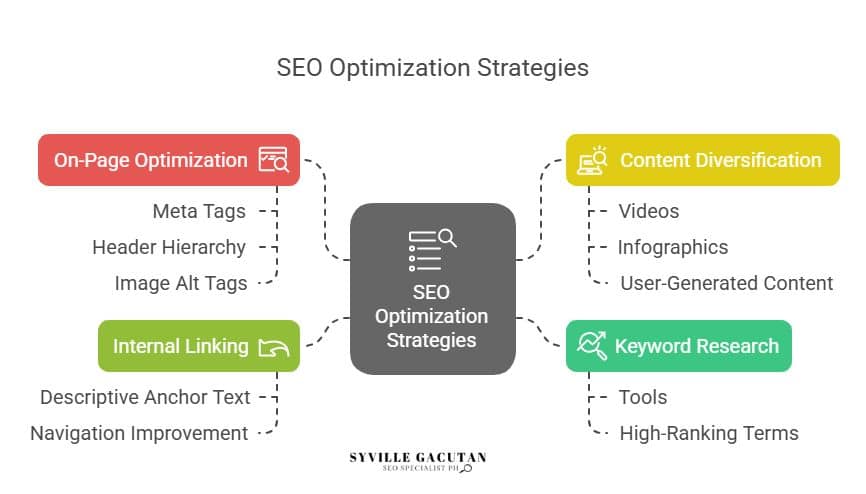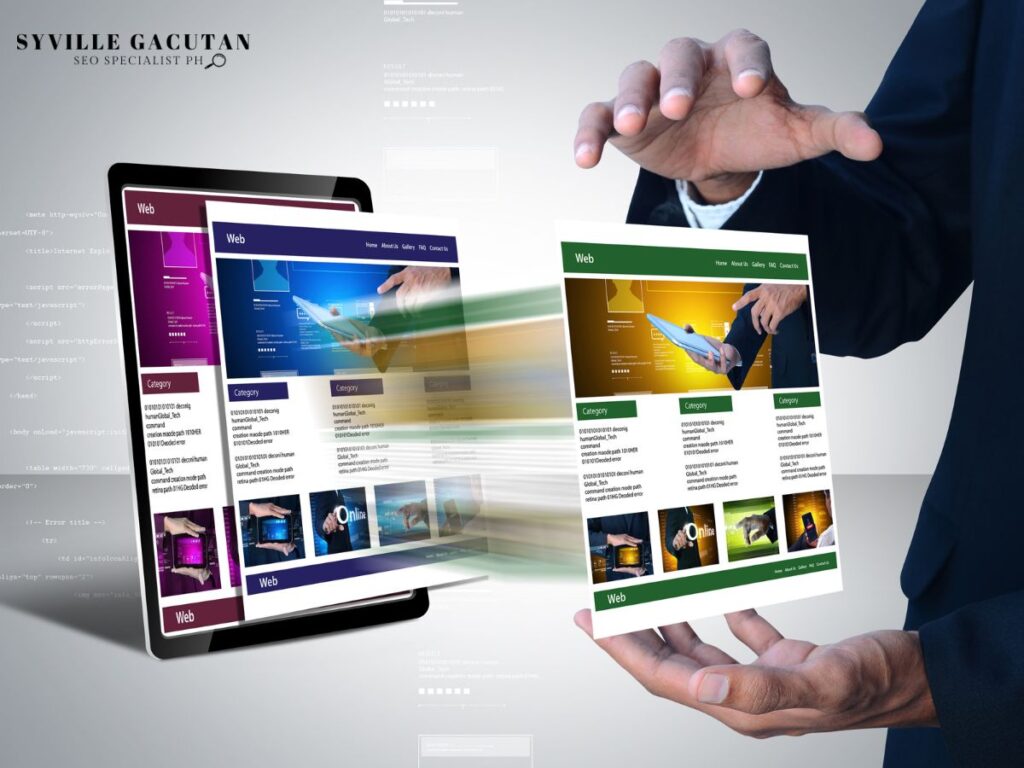
7 Authentic SEO Tips for Content Marketers
Effective SEO for content marketers begins with understanding and engaging your audience through detailed personas and demographic research. Generate relevant topics using comprehensive keyword research and fill content gaps identified through competitor analysis. On-page optimization, including meta tags and balanced keyword density, enhances search visibility. Increasing the variety of material types, including infographics and videos, catering to varied audience preferences. Internal linking is vital for maintaining content hierarchy and enhancing user navigation. A well-structured content calendar ensures consistent publishing aligned with brand messaging. Finally, focus on mobile optimization to deliver an engaging user experience. Explore further to refine these best SEO practices for content marketers.
Key Takeaways
- Conduct thorough audience research to tailor content to user intent and preferences.
- Utilize comprehensive keyword research tools to identify high-ranking and relevant terms.
- Optimize on-page elements such as meta tags, header hierarchy, and image alt tags for better search visibility.
- Diversify content formats with videos, infographics, and user-generated content to boost engagement and SEO.
- Implement strategic internal linking with descriptive anchor text to improve navigation and page importance.

1. Figure Out Your Audience
Knowing your target is essential to creating a successful SEO content strategy. To create content that resonates and ranks well, it is essential to delve into audience personas—detailed profiles representing segments of your target market. These personas help you understand user intent, the underlying reasons why a user conducts a particular search. By aligning your content with these intents, you cater to the needs and questions of your audience, thereby enhancing engagement.
Demographic research forms the backbone of audience personas, providing insights into age, gender, location, and income levels. This information shapes your content’s tone, style, and substance, ensuring it meets the expectations and needs of your audience.
Understanding content preferences, such as preferred types of media (e.g., videos, blogs, or infographics) and topics of interest, further refines your strategy, allowing you to deliver value in formats your audience finds most engaging.
Engagement metrics serve as an evaluative tool to gauge the effectiveness of your content strategy. Metrics such as time on page, bounce rate, and social shares reveal how well your content resonates with your audience personas.
2. Generate a List of Topics

To effectively generate a list of topics that align with your SEO content strategy, start by conducting comprehensive keyword research. This foundational step aids in identifying the terms and phrases your target audience is searching for, thereby ensuring your content resonates with their needs.
Utilize tools like Google Keyword Planner, Ahrefs, or SEMrush to uncover high-ranking keywords that are relevant to your niche. These insights are critical in crafting content that not only attracts traffic but also engages your audience meaningfully.
Beyond keyword research, competitor analysis plays a vital role in topic generation. By examining what your competitors are doing, you can identify gaps in their content offerings or spot trending topics they’ve successfully capitalized on.
This analysis not only enriches your topic list but helps you differentiate your content by offering unique insights or angles.
Once you have a solid list of potential topics, consider how these can be leveraged for content promotion. Effective promotion strategies are crucial for maximizing reach and engagement.
Think about how your topics can be shared across different platforms, whether through social media, email newsletters, or collaborations with influencers.
Audience engagement should remain at the forefront of your topic selection process. Choose topics that encourage interaction, be it through comments, shares, or likes.
Engagement metrics can serve as performance metrics, providing valuable insights into what resonates with your audience. By monitoring these metrics, you can refine your content strategy over time, ensuring a continual alignment with audience interests and SEO objectives.
Ultimately, a well-curated list of topics supports sustained content success.
3. Optimize On-Page Elements

After generating a comprehensive list of topics, the focus shifts to optimizing on-page elements to enhance SEO performance.
On-page optimization involves fine-tuning various components of web pages to improve their visibility and relevance in search engine results. One crucial element is the use of meta tags, which provide search engines with concise information about the page’s content. Crafting effective title and description tags can significantly impact click-through rates by making your content more appealing to users.
Keyword density also plays a pivotal role in on-page SEO. While it is important to incorporate target keywords naturally within the content, overstuffing can lead to penalties from search engines. Strive for a balanced approach where keywords are used strategically to enhance the content’s relevance without compromising its quality.
Image optimization is another key factor. Properly sized and compressed images not only improve page loading speed but also contribute to a better user experience. Including descriptive alt tags for images further aids in search engine indexing and accessibility.
Header hierarchy is essential for structuring content in a coherent manner. Using header tags (H1, H2, H3) appropriately helps both search engines and readers understand the main topics and subtopics covered in the content.
This structure enhances content readability, making it easier for users to digest information.
4. Use a Variety of Content Formats

Utilizing a diverse array of content formats is essential for engaging a broader audience and enhancing SEO performance. In today’s digital landscape, consumers are not only looking for information but also for diverse ways to consume content. By incorporating a mix of video content, infographic design, interactive quizzes, audio storytelling, and user generated content, marketers can cater to the varied preferences of their audience while optimizing search engine visibility.
Video content, for instance, is not just a powerful storytelling tool but also a significant driver of traffic. With platforms like YouTube being the second largest search engine, creating engaging and informative videos can boost rankings and reach.
Similarly, infographic design is a visually appealing way to present complex data succinctly, enhancing shareability and engagement metrics, which are critical for SEO.
Interactive quizzes serve as engaging tools that encourage participation and can significantly increase the time users spend on your website. This, in turn, signals to search engines that your site is offering valuable content.
Audio storytelling, through podcasts or audio blogs, taps into the growing number of audio content consumers, broadening your reach and offering flexibility in how your message is consumed.
Lastly, user generated content, such as reviews and testimonials, not only builds trust but also enriches your content strategy by providing fresh and authentic material, enhancing SEO with diverse keywords and perspectives.
5. Utilize Internal Linking

Building a robust content strategy involves not only diversifying content formats but also optimizing their interconnectedness through internal linking. This technique is vital in establishing a coherent content hierarchy that guides both search engines and users through your website. By strategically employing linking strategies, content marketers can significantly enhance the visibility and accessibility of various pages, facilitating a seamless user experience.
Internal linking is more than just connecting one page to another; it is about creating a pathway that encourages users to explore additional content, keeping them engaged and informed. A well-thought-out content hierarchy is crucial, as it determines which pages are prioritized and how they relate to each other. By connecting high-value pages with relevant anchor text, content marketers can subtly guide users while simultaneously signaling to search engines the importance of those pages.
Anchor text plays a pivotal role in internal linking strategies. It should be descriptive and relevant to the content it links to, offering users a clear understanding of what to expect. This not only improves user experience but also provides SEO benefits by enhancing the semantic relevance of linked pages. Search engines utilize this contextual information to better index and rank your website, potentially boosting its authority in the process.
Ultimately, the SEO benefits of effective internal linking are manifold. It ensures that search engine crawlers can efficiently navigate your website, indexing its content more thoroughly. Additionally, improved navigation leads to increased time spent on your site, reducing bounce rates and potentially elevating your website’s search engine rankings.
Thus, internal linking is an indispensable element of any content marketer’s arsenal.
6. Create a Content Calendar

Developing a content calendar is a strategic move that can significantly enhance the efficiency and effectiveness of your content marketing efforts. By meticulously planning your content themes, you ensure that every piece of content aligns with your brand’s messaging and goals.
A content calendar allows you to establish a consistent publishing frequency, which is crucial for maintaining audience engagement. Regularly scheduled content keeps your audience informed and builds a level of trust and anticipation that can lead to increased interaction and loyalty.
Incorporating seasonal trends into your content calendar is another vital aspect. Recognizing the ebb and flow of your audience’s interests throughout the year enables you to create timely and relevant content that meets their needs and captures their attention.
This strategic alignment can significantly boost your content’s reach and resonance, leading to higher engagement rates.
Furthermore, a content calendar provides the framework to track performance metrics systematically. By reviewing these metrics regularly, you can gain invaluable insights into what types of content are resonating with your audience and which are underperforming.
This data-driven approach allows you to refine your content themes and publishing frequency, ensuring that your strategy remains effective and aligned with your marketing goals.
7. Focus on Mobile Optimization

As mobile devices continue to dominate the digital landscape, ensuring your content is optimized for mobile users is paramount for successful SEO. With a growing number of users accessing content via smartphones and tablets, mobile optimization is not just a trend but a necessity.
A cornerstone of effective mobile optimization is responsive design, which ensures your website adapts seamlessly to various screen sizes, providing an optimal viewing experience across all devices. This adaptability is crucial for maintaining user engagement and reducing bounce rates.
Another critical aspect to consider is mobile speed. Slow-loading pages can frustrate users and lead to decreased traffic and higher abandonment rates. Therefore, optimizing images, leveraging browser caching, and minimizing server response times are essential practices to enhance mobile speed.
Furthermore, enhancing user experience is integral to mobile optimization. This involves intuitive touch navigation, where elements like buttons and menus are designed to be easily accessible and usable on smaller screens. Simplifying navigation and ensuring that interactive elements are touch-friendly can significantly improve user engagement and satisfaction.
Utilizing mobile analytics is also vital in understanding user behavior on mobile devices. By analyzing data such as bounce rates, session duration, and conversion paths, content marketers can gain valuable insights into how users interact with their mobile content. This information can guide strategic decisions to refine and enhance mobile optimization efforts continually.
Focusing on these key elements—responsive design, mobile speed, user experience, touch navigation, and mobile analytics—ensures that your content is not only accessible but also appealing to the ever-growing mobile audience.
Final Thoughts
Implementing these seven authentic SEO tips is essential for content marketers looking to enhance their visibility and engagement in the digital landscape. By understanding your audience through detailed personas, you can create content that resonates deeply with their needs and preferences. Generating relevant topics via comprehensive keyword research and competitor analysis will ensure your content remains impactful and aligned with user intent. Optimizing on-page elements, diversifying content formats, and leveraging internal linking strategies further strengthen your SEO efforts. Additionally, a well-structured content calendar and a focus on mobile optimization will keep your content relevant and accessible.
Ready to elevate your content marketing strategy with expert SEO insights? Syville Gacutan, an experienced SEO Specialist in the Philippines, can help you craft data-driven, search-optimized content that drives measurable results. Connect with Syville today and start transforming your content into a powerful SEO asset.